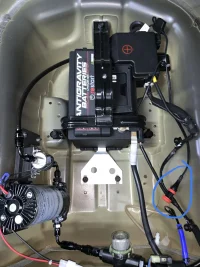This seems like a good point for me to raise the question of weight distribution. I know that you are into handling tweaks and mods. How would losing 40-50 lbs. in the rear affect cornering? I think that the 4 cylinder engine provides better weight distribution than the 6 cylinder. At least, our Premium feels more nimble and balanced than the GT1, even with the Eibach sways on the GT1. Maybe it's tires though. The less grip of the Bridgestone on the Premium lets the car slide instead of the rear stepping out and catching, like the stock sways on the GT1 did, on Michelin PS4(S) - as observed by many on the forum over the years. Anyway, my understanding is that KIA put the heavy battery back there to obtain better weight balance. That seems more important than losing 40-50 lbs.
Excellent question. The short answer is that the points you raised are all valid and your assumptions are, for the most part, correct. The long answer, however, is more nuanced than simply a matter of weight distribution.
The reason those 40-50 lbs would matter has to do with... mass centralization. It is a design concept more often talked about in motorcycle world than in automotive circles. However, the principles apply just the same. The simplest way to think about it is to imagine two cars, each with the same weight, but one with its weight distributed like a dumb bells, while the other resemble a big ball bearing with a thin rod through it. Which one would handle better? It doesn't take much to realize the latter will rotate faster and be more stable in all three axis of freedom - pitch, yaw and roll.
Obviously, no car has perfect mass centralization; no car ever will. Nevertheless, just look at how a car is typically designed when cost becomes less of an issue. Just about ALL the supercars gravitate towards a mid-engine configuration... and mass centralization is the reason why that is the case. Unfortunately, it is also the least practically of all the engine configurations, which is why the overwhelming majority of automobiles have the engine up front, freeing up the rest of the car for cargo/passenger space. It is a necessary engineering compromise. If there is a way an automotive engineer can cheat that compromise to gain better vehicle dynamics - even if it's just a little - no doubt he/she would jump at the chance.
Herein lies the significance of that 40-50 lbs savings, which is actually quite far away from the actual center of the car's pitch/yaw axis. It'll allow the car to rotate faster and be more dynamically stable under high lateral-G maneuvers (i.e., faster cornering, emergency swerves, switchbacks, chicanes, slaloms, etc.).
Static weight distribution is a good metrics to gauge a car, but in HPDE, that static weight distribution goes out the window, as the car is always experiencing weight transfer, left, right, front, rear and every combination thereof. A perfect 50/50 weight distribution is nice to have, but ask any chassis engineer and they will tell you that is far from the end game. Perfect mass centralization OTOH
is the Holy Grail that improves everything.






